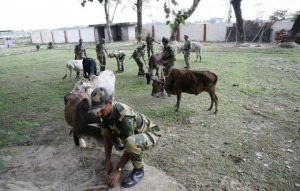Millions of cattle from Maharashtra will soon join the stream from West Bengal, Rajasthan, Punjab, Himachal Pradesh, Jharkhand, Madhya Pradesh, Uttar Pradesh, Haryana, Bihar and Uttarakhand that are smuggled annually to Bangladesh. This will be the unintended consequence of the Maharashtra government’s bullheaded decision to impose a ban on the slaughter of cows, bulls, steers and oxen.
 The other consequence of the ban is that this easing of the demand-supply gap in Bangladesh will bring cheer to beef consumers there during the next Eid festivities. Dhaka, too, will benefit, since its commercial tax department imposes a high tax even on smuggled cattle. Cattle smuggling is a multimillion-dollar enterprise in the India-Bangladesh borderland. The stakes are high because district-level political elites on the Indian side are involved in this illegal enterprise.
The other consequence of the ban is that this easing of the demand-supply gap in Bangladesh will bring cheer to beef consumers there during the next Eid festivities. Dhaka, too, will benefit, since its commercial tax department imposes a high tax even on smuggled cattle. Cattle smuggling is a multimillion-dollar enterprise in the India-Bangladesh borderland. The stakes are high because district-level political elites on the Indian side are involved in this illegal enterprise.
In 2010, 1,01,381 cattle-heads were intercepted by the Border Security Force (BSF). In 2011, the number rose to 1,35,291, while in 2012, the cattle-heads seized at the border were 1,20,724. In 2013, the figure was as high as 1,22,000. These constitute a fraction of the around 1.5 million cows smuggled into Bangladesh. Their estimated value is more than $500 million.
Regardless of Union home minister Rajnath Singh’s anxieties depriving Bangladesh of beef and his instructions to the BSF to stop cattle smuggling, the highly efficient and organised smuggler syndicates on both sides of the India-Bangladesh border will work overtime to adjust the flow of the bovine creatures from Maharashtra.
What Singh perhaps doesn’t know is that a heavily-guarded border can easily be a segment where even the border guards are involved in illicit crossborder trade, including that of cattle.
beef-ban
The BSF’s camouflage-patterned uniforms do not necessarily match their everyday relations with borderlanders, who, for historical reasons, cannot —and don’t — restrict their imagination to belonging to the territory of a single state. The very sentinels of the state are often susceptible to the lure of the profits of smuggling and are active agents in these illicit activities.
It is perhaps the India-Bangladesh borderland’s worst-kept secret that BSF outposts routinely organise the auctioning of small patches of land where cattle from distant states of India are herded before rustlers push them through 69 designated — and any number of clandestine — corridors into Bangladesh. The highest bidders are the organised smuggler gangs.
Trucks laden with cows, bulls and oxen speed through roads in Murshidabad in West Bengal all through the night and unload the animals close to BSF border outposts from where couriers guide them into the safe hands of their Bangladeshi counterparts.
When the state makes empty noises on greater restrictive measures on the border, or steps up surveillance as a true ‘gatekeeper’ that enforces the prevention of smuggling, organisers of the illegal outflow of cattle adapt to smarter means to strengthen their own organisational and methodological prowess. The Indian state could assume all kinds of restrictive strategies to significantly deter cattle smuggling. But it will only turn borderland societies with little or no access to jobs into landscapes of control and fear without necessarily achieving the intended goal of stopping illicit trade.
If the measures are quite restrictive —maintaining a 3-km exclusion zone, for instance — smuggling will stop for awhile, but they will neither fully block the traditional corridors and methods in the long run nor will it disrupt the ‘entrepreneurs’. In the India-Bangladesh borderlands, there’s an ‘overt defiance’ of state policies of control.
Both India and Bangladesh characterise the modern state’s claims to exclusive rights on authorising and regulating the movement of humans and goods. Both claim monopoly over legitimate means to control this traffic. In the Indian case, however, what with continuing illegal immigration from Bangladesh, such claims are halfway measures that aren’t part of any welldefined policy.
While the complete easing of state strategies of territoriality (read: open borders) is hardly a convincing argument for the India-Bangladesh sector because of genuine fears of crossborder terrorism, what may work to curb smuggling and illegal migration is a more rational approach to the twin problems.
In the securitised world of the borderland, creation of employment opportunities in both Bangladesh and Indian border districts, free trade between the two countries with designated border-trading posts in the frontier states and legalising commerce in cattle are far more mutually beneficial than the current Maginot Line type-strategy.
-Economic Times Blog
















